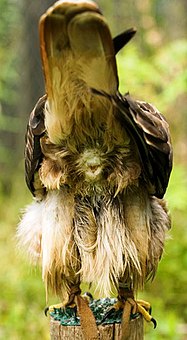

Hi Everybody!!
Introducing the new female Black Vulture our JerryBuzz selected for a mate. She is really beautiful (for a buzzard!). JerryBuzz (formerly BabyBuzz) grew up in the tree across from Kates Driveway, so I have been able to photograph his life history since March. He is around 6 months old when making the selection for his mate. I do not know how they communicate, but she now lives in the tree with JerryBuzz. (As there are only 2 living in this tree, I can tell who they are). Below are the links to the photostudies of these fine black vultures. Also, I have shared info from Wikipedia on Mating (specifically birds). Enjoy!








https://en.wikipedia.org/wiki/Mating
Mating
From Wikipedia, the free encyclopedia
In biology, mating is the pairing of opposite-sex or hermaphroditic organisms, usually for the purposes of reproduction. Some definitions limit the term to pairing between animals,[1] while other definitions extend the term to mating in plants and fungi. Fertilization is the fusion of both sex cell or gamete. Copulation is the union of the sex organs of two sexually reproducing animals for insemination and subsequent internal fertilization. Mating may also lead to external fertilization, as seen in amphibians, fishes and plants. For the majority of species, mating is between two individuals of opposite sexes. However, for some hermaphroditic species, copulation is not required because the parent organism is capable of self-fertilization (autogamy); for example, banana slugs.
For animals, mating strategies include random mating, disassortative mating, assortative mating, or a mating pool. In some birds, it includes such behaviors as nest-building andfeeding offspring. The human practice of mating domesticated animals and of artificially inseminating them is part of animal husbandry.
Animals
In some terrestrial arthropods, including insects representing basal (primitive) phylogenetic clades, the male deposits spermatozoaon the substrate, sometimes stored within a special structure. Courtship involves inducing the female to take up the sperm package into her genital opening without actual copulation. In groups such as dragonflies and many spiders, males extrude sperm into secondary copulatory structures removed from their genital opening, which are then used to inseminate the female (in dragonflies, it is a set of modified sternites on the second abdominal segment; in spiders, it is the male pedipalps). In advanced groups of insects, the male uses its aedeagus, a structure formed from the terminal segments of the abdomen, to deposit sperm directly (though sometimes in a capsule called a "spermatophore") into the female's reproductive tract.
Other animals reproduce sexually with external fertilization, including many basal vertebrates. Vertebrates (such as reptiles, somefish, and most birds) reproduce with internal fertilization through cloacal copulation (see also hemipenis), while mammals copulate vaginally.
https://en.wikipedia.org/wiki/CloacaCloaca
From Wikipedia, the free encyclopedia
In zoological anatomy, a cloaca /kloʊˈeɪkə/ is the posterior opening that serves as the only opening for the intestinal, reproductive, and urinary tracts of certain animal species. Allamphibians, birds, reptiles, and monotremes possess this orifice, from which they excrete bothurine and feces, unlike most placental mammals, which possess two or three separate orifices for evacuation.
The cloacal region is also often associated with a secretory organ, the cloacal gland, which has been implicated in the scent marking behavior of some reptiles, amphibians and monotremes.

An avian cloaca or vent; in this example, a red-tailed hawk (Buteo jamaicensis)
Birds[edit]
In birds, the cloaca is the terminal chamber of the gastrointestinal and urogenital systems, opening at the vent. Excretory systems with analogous purpose in certain invertebrates are also sometimes referred to as "cloacae".
Birds also reproduce with this organ; this is known as a cloacal kiss. Birds that mate using this method touch their cloacae together, in some species for only a few seconds, sufficient time forsperm to be transferred from the male to the female.[1] The reproductive system must be re-engorged prior to the mating season of each species. Such regeneration usually takes about a month. Birds generally produce one batch of eggs per year, but they will produce another if the first is taken away. For some birds, such as ostriches, cassowaries, kiwi, geese, and some species of swans and ducks, the males do not use the cloaca for reproduction, but have aphallus. In those, the penis helps ensure that water does not wash away the male's sperm during copulation.[citation needed]
One study[2] has looked into birds that use their cloaca for cooling (see urohidrosis).[3]

****Link to Photostudy in G+Album:
(Click On!)
https://plus.google.com/u/0/photos/117645114459863049265/albums/5942571617913089697


...this is brendasue signing off from Rainbow Creek. See You next time!

***Bonus Photostudy Link:
https://plus.google.com/photos/117645114459863049265/albums/5939430620476624193
HIGHLIGHTS FROM G+ AUTO BACK UP (Thanks Guys!)





Link to yellow flowers album:
https://plus.google.com/photos/117645114459863049265/albums/5939754532232996209

O+O

No comments:
Post a Comment
Hi Everybody! Please say hello and follow so I know you are here! Due to the inconsideration of people trying to put commercials on my blog comment area, I have restricted use of anonymous posts. Sorry that some hurt all.
My public email is katescabin@gmail.com No spammers or trolls